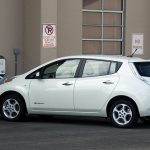Oregon debuts first pay-per-mile driving tax in the U.S.
OReGO, a new pilot program in Oregon, is attempting to change the way road and bridge infrastructure is funded, reports the Portland Business Journal. The Oregon Road Usage Charge will charge drivers on a per-mile basis, monitoring drivers’ use of roads, and charging a fixed fee per mile driven. Cars will be provided with mile-tracking technology that will also be able to note whether roads are public, private or out-of-state.

Oregon is becoming the first state in the union to turn to a Vehicle Miles Traveled tax to fund its transportation needs. Image from Kirt Edblom.
The state’s department of transportation selected three companies to launch the program and issue a mile-tracking device which plugs into cars’ computers in order to collect and submit “mileage and tax information to the state.” The program will enroll up to 5,000 volunteers and will begin July 1. The volunteers agree to pay 1.5 cents per mile traveled on public roads, instead of the gas tax.
While the state’s program is the first of its kind in the U.S., the debate over a gas tax versus a tax on VMT, or vehicle miles traveled, is not new. The gax tax hasn’t been raised in decades, but at the current rate, it doesn’t come close to covering the repair and maintenance of the country’s ailing roads. “We know in the future, our ability to pay for maintenance and repair… will be severely impacted if we continue to rely on the gas tax,” Shelley Snow of the Oregon Department of Transportation told U.S. News & World Report.
Clearly, funds are needed, but drivers disagree on how to raise them. Under VMT pricing, for example, gas-guzzling SUVs would pay the same amount as fuel-efficient hybrid or electric vehicles on a per-mile basis, raising questions about the equitability of the charges and about how much damage different kinds of vehicles inflict on infrastructure.
Proponents of VMT charging, like Jim Whitty, who created the Oregon program, claim that the system is fair to everyone involved: “[D]rivers of fuel-efficient vehicles bristle at the idea that people who pollute more would get a better deal. The fact is, what sold the Oregon legislature on the VMT fee was the idea that it promotes fairness and requires all drivers — even those with electric cars — to pay for the infrastructure they use,” Whitty explained to Streetsblog in 2013.
Will VMT taxes better serve the state compared to the gas tax? “Fuel consumption used to be a reasonably good proxy for road use, but it isn’t anymore,” explained Whitty. “Charging people directly for their use of the roads makes more sense. If revenues go down, it will be because people are driving less, and therefore creating less wear and tear on the roads, as well as less demand for system expansion.”
The VMT program has its detractors, too. “This program targets hybrid and electric vehicles, so it’s discriminatory,” Patrick Connor, a Beaverton, Oregon resident who has been driving an electric car since 2007, told U.S. News & World Report. In a recent editorial on Grist.org, journalist Ben Adler outlined reasons to forgo the VMT tax in favor of raising the gas tax: “A VMT tax makes all users pay equally for their usage if you define usage in the narrow sense of miles traveled. But drivers of gas guzzlers are using, and abusing, public goods such as roads and air far more than drivers of efficient cars are.”
Learn more about the program online.
Related Posts
Category: Transportation

















